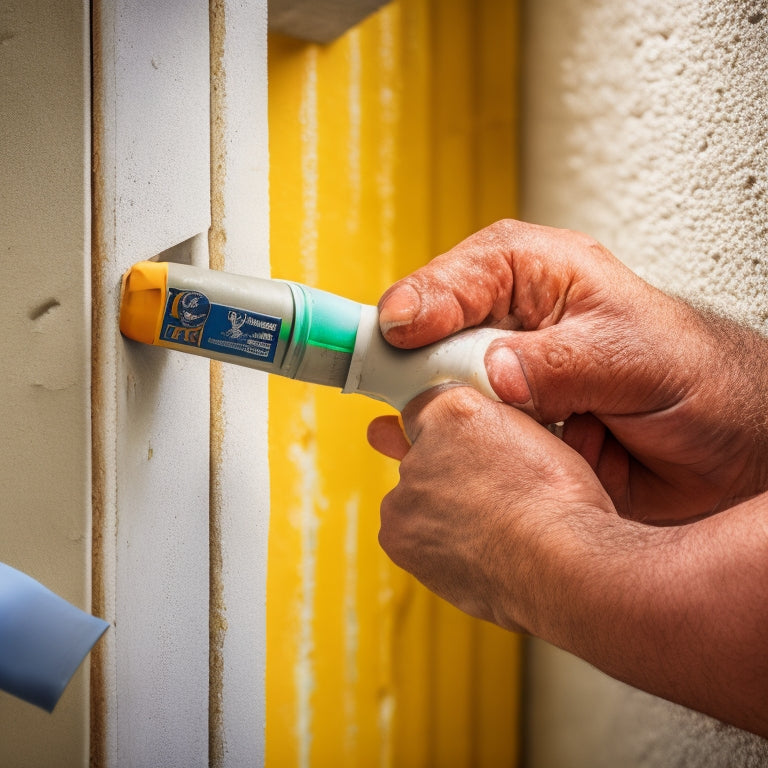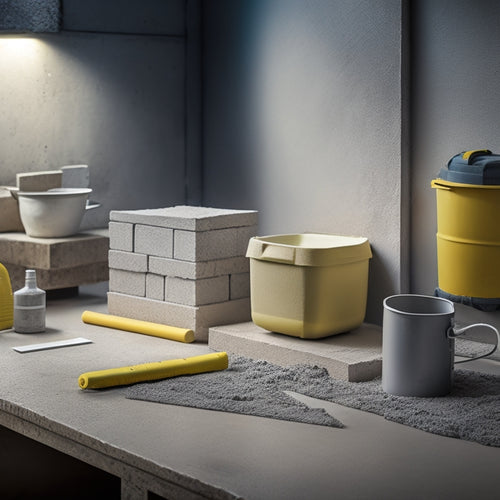
Reliable Tools for Concrete Block Sealant Application
Share
When it comes to concrete block sealant application, you need reliable tools that meet specific criteria to guarantee efficient and professional results. A good sealant gun should be ergonomic, durable, and compatible with various cartridges. Nozzles and tips must be precision-matched for peak flow and bead quality. Durable applicator wands and sealant flow control systems are also essential for consistent performance. Regular cleaning and maintenance are crucial to prevent clogs and extend tool lifespan. By choosing the right tools and following proper procedures, you'll achieve professional results and minimize errors. Now, take a closer look at each of these key factors to enhance your sealant application process.
Key Takeaways
• Choose a durable sealant gun with ergonomic design and balanced weight for comfortable use and reduced fatigue.
• Select nozzles and tips compatible with your sealant cartridge and suitable for concrete block applications.
• Ensure applicator wand durability with heavy-duty materials and ergonomic design for consistent flow and control.
• Invest in a reliable sealant flow control system with viscosity control and consistent bead sizes for professional results.
• Regularly clean and maintain your tools with a schedule to prevent clogs, ensure reliability, and extend tool lifespan.
Sealant Gun Selection Criteria
When selecting a sealant gun for concrete block sealant applications, you should consider several key factors to guarantee the tool meets your specific needs and optimizes performance.
One significant aspect is the type of sealant gun, as there are various options available, including manual, pneumatic, and battery-powered guns. Each type has its advantages and disadvantages, so it's important to choose the one that suits your project requirements and personal preferences.
Ergonomic design is another important consideration, as it directly impacts your comfort and productivity. Look for a sealant gun with a comfortable grip, balanced weight distribution, and intuitive controls. This will enable you to work efficiently for extended periods without fatigue or discomfort.
Additionally, consider the gun's durability, maintenance requirements, and compatibility with different sealant cartridges. By carefully evaluating these factors, you can select a sealant gun that streamlines your workflow, reduces downtime, and helps you achieve professional-quality results.
With the right tool in hand, you'll be free to focus on your work, unencumbered by equipment limitations.
Nozzle and Tip Compatibility
Selecting the right nozzle and tip for your concrete block sealant application is essential, as it directly affects the precision and quality of the sealant bead. You need to verify that the nozzle and tip you choose are compatible with your sealant gun and the specific application you're working on.
When it comes to nozzle types, you'll typically find three main categories:
-
Standard nozzles: These are the most common type, suitable for general-purpose applications.
-
Fan nozzles: These are ideal for wide, flat surfaces and provide a uniform sealant pattern.
-
Extension nozzles: These are perfect for reaching tight spaces and corners.
In addition to nozzle types, you'll also need to take into account tip sizes. The tip size will determine the bead size and flow rate of the sealant. A smaller tip size will produce a smaller bead, while a larger tip size will produce a larger bead.
Make sure to choose a tip size that's appropriate for your specific application to achieve the desired results. By selecting the right nozzle and tip combination, you'll be able to achieve a professional-looking finish with ease.
Applicator Wand Durability
You'll find that a durable applicator wand is essential to maintaining a consistent sealant flow and reducing fatigue during extended use.
When selecting an applicator wand, consider the materials used in its construction. Look for wands made from high-quality, heavy-duty materials that can withstand the rigors of repeated use. A durable wand will reduce the likelihood of breakage, ensuring that your sealant application process remains uninterrupted.
In addition to material selection, applicator wand ergonomics play a critical role in reducing fatigue and improving overall performance. An ergonomically designed wand will fit comfortably in your hand, allowing you to maintain a steady grip and precise control.
This is particularly important during extended use, as a well-designed wand will reduce strain on your hand and wrist, enabling you to work for longer periods without discomfort.
Sealant Flow Control Systems
Effective sealant flow control systems rely on precision-engineered components that regulate the release of sealant material, guaranteeing consistent bead sizes and minimizing waste. As you work with concrete block sealant application, you need a system that provides precision and control. This is where a reliable sealant flow control system comes in.
Here are three key benefits of a well-designed sealant flow control system:
-
Accurate sealant viscosity control: You get to adjust the viscosity of the sealant to suit the specific application, guaranteeing the right amount of material is dispensed.
-
Consistent bead sizes: The system guarantees that the sealant is applied in consistent bead sizes, reducing the risk of errors and rework.
-
Increased efficiency with automated application systems: By automating the application process, you can increase productivity and reduce labor costs, giving you more freedom to focus on other tasks.
With a reliable sealant flow control system, you can achieve professional results with ease. By investing in a high-quality system, you'll be able to work efficiently and effectively, enjoying the freedom to take on more projects and grow your business.
Cleaning and Maintenance Tools
When working with concrete block sealants, your tools require regular cleaning and maintenance to prevent clogs, assure consistent performance, and extend their lifespan.
You need to develop a routine that includes daily, weekly, and monthly cleaning techniques to keep your tools in prime condition. Start by wiping down your tools with a solvent-soaked cloth after each use, followed by a thorough cleaning with a wire brush to remove any dried sealant.
For more thorough maintenance, create a schedule that includes weekly checks for worn-out parts and monthly deep cleaning of your tools' nozzles and hoses.
To guarantee your tools continue to perform at their best, establish a maintenance schedule that outlines specific tasks to be completed at set intervals. This will help you stay on track and prevent costly repairs or replacements.
By incorporating regular cleaning and maintenance into your workflow, you'll be able to work efficiently and effectively, without worrying about tool failure or downtime.
Frequently Asked Questions
How Do I Prevent Sealant From Dripping Onto Surrounding Surfaces?
To prevent sealant drips, you're taking the right step by planning ahead. Use masking tape, drop cloths, or plastic sheets to protect surrounding surfaces, ensuring a mess-free application and avoiding costly cleanups.
Can I Use a Sealant Gun With Extension Poles for Hard-To-Reach Areas?
Like a surgeon wielding a precision instrument, you'll master sealant application techniques with a sealant gun and extension pole, leveraging its advantages to reach tight spaces and corners with ease, minimizing mess and maximizing efficiency.
What Is the Ideal Temperature for Applying Concrete Block Sealant?
When applying concrete block sealant, you'll want to guarantee ideal application conditions. Typically, temperatures between 50°F and 90°F (10°C and 32°C) are best, as extreme temperatures can negatively impact sealant performance and longevity, affecting the overall quality of your project.
Are There Any Sealants Compatible With Epoxy-Based Paints?
As you open the door to a perfectly sealed concrete block, you'll find that acrylic, polyurethane, and silane-modified polyether sealants harmonize with epoxy-based paints, ensuring a strong, durable bond that sets you free from maintenance worries.
Can I Reuse Nozzle Tips After Cleaning and Drying Them Properly?
You can extend nozzle tip lifespan through proper maintenance, but reusing them might compromise sealant longevity. Clean and dry nozzle tips thoroughly to prevent clogs, and consider replacing them regularly to guarantee peak sealant performance and quality.
Conclusion
As you stand tall, armed with the right tools for concrete block sealant application, you're not just building a structure - you're building a fortress.
The sealant gun is your trusty sword, the nozzle and tip your precision arrows, the applicator wand your sturdy shield, and the sealant flow control system your strategic battle plan.
With cleaning and maintenance tools as your loyal allies, you're ready to conquer the toughest construction challenges.
Related Posts
-

What Tools Do I Need for Concrete Wall Repair
As you prepare for a concrete wall repair job, you'll need a variety of tools to guarantee a successful outcome. Star...
-

10 Best Tools for Sealed Concrete Flooring on Budget
When starting on a sealed concrete flooring project on a budget, you'll need to prioritize essential tools without sa...
-

What Tools Do I Need for Concrete Block Laying
You'll need a thorough set of tools to guarantee accurate, efficient, and professional concrete block laying. Essenti...


